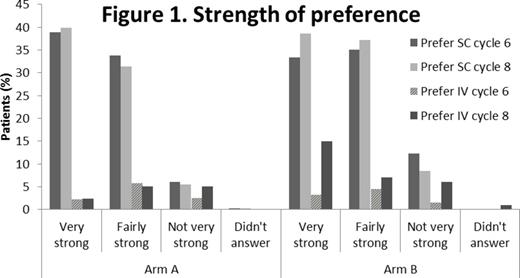Abstract
Background
Rituximab in combination with chemotherapy is the standard of care for patients with diffuse large B-cell lymphoma (DLBCL) and follicular lymphoma (FL). To improve patient convenience and to reduce healthcare resource burden, a subcutaneous (SC) formulation of rituximab has been developed and has been shown to be clinically comparable to intravenous (IV) rituximab. The aim of this study was to evaluate patient preference for rituximab IV or SC administration.
Methods
Prefmab (NCT01724021) is a randomized, open-label, crossover phase IIIb study. Eligible patients were aged ≥18 to ≤80 years with previously untreated CD20+ DLBCL (IPI 1-4 or 0 with bulky disease) or FL (FLIPI grade 1-3a), at least 1 bidimensionally measureable lesion ≥1.5cm at its largest dimension by computed tomography, and an ECOG performance status ≤3; all provided written informed consent. Patients received 8 cycles of rituximab according to 2 schedules: Arm A received 1 cycle of rituximab IV (375mg/m2) and 3 cycles of rituximab SC (1400mg) then 4 cycles of rituximab IV; Arm B received 4 cycles of rituximab IV (375mg/m2) then 4 cycles of rituximab SC (1400mg). Alongside rituximab, both arms received 6-8 cycles of chemotherapy (CHOP [cyclophosphamide, doxorubicin, oncovin, prednisone], CVP [cyclophosphamide, vincristine, prednisone], or bendamustine as per standard local practice). A Patient Preference Questionnaire (PPQ) was conducted post-rituximab therapy at cycles 6 and 8. The primary endpoint was overall preference for rituximab IV or SC. The strength of patient preference was also assessed (very strong, fairly strong, or not very strong). Adverse events (AEs), including administration-related reactions, were evaluated according to NCI-CTCAE version 4.0.
Results
At the primary data cut-off (January 19, 2015), the intent-to-treat population comprised 743 patients (Arm A: n=372; Arm B: n=371). The majority of patients had DLBCL (63%). The median age was 60 years (range 18-80) and baseline characteristics were balanced between arms. One hundred and twenty patients discontinued immunochemotherapy treatment prematurely, primarily due to AEs (n=52), but entered follow-up. A further 108 patients (Arm A: n=48; Arm B: n=60) discontinued the study and did not complete follow-up, primarily due to death (53 patients [DLBCL: n=48; FL: n=5], 19 of whom died due to progressive disease [DLBCL: n=16; FL: n=3]), patient request/withdrawal of consent (n=23), or AEs (n=9). Rates of study discontinuation and treatment discontinuation were balanced between arms. The PPQ was completed by 620 patients at cycle 6 and 591 at cycle 8. At cycle 6, rituximab SC was preferred by 80% (n=495) of patients (Arm A: 79%; Arm B: 81%) and rituximab IV by 10% (n=62; Arm A: 11%; Arm B: 9%), while 10% (n=63) had no preference (Arm A: 10%; Arm B: 10%). At cycle 8, the respective values were 81% (n=477; Arm A: 77%; Arm B: 84%), 11% (n=66; Arm A: 13%; Arm B: 10%), and 8% (n=48; Arm A: 10%; Arm B: 6%). The strength of patient preference for rituximab SC or IV is shown in Figure 1. Of patients who preferred rituximab SC, the main reasons were 'less time in the clinic' (cycle 6: 68%; cycle 8: 69%) and 'feels more comfortable during administration' (cycle 6: 37%; cycle 8: 37%). The mean cumulative rituximab administration time (mean ± standard deviation) was 865 ± 401 min for rituximab IV compared with 37 ± 100 min for rituximab SC. AEs were generally balanced between rituximab IV and SC administration, with the exception of gastrointestinal disorders (IV: 55%; SC: 31%) in patients with FL, notably nausea (IV: 28%; SC: 11%), constipation (IV: 14%; SC: 6%), and vomiting (IV 12%; SC 2%). No new safety signals were detected.
Conclusions
Most previously untreated patients with CD20+ DLBCL or FL preferred SC compared with IV administration of rituximab, mainly due to reduction in the duration and discomfort of administration.
Rummel:Roche: Honoraria, Membership on an entity's Board of Directors or advisory committees, Research Funding. Plenteda:Roche: Other: Sub-investigator. Mendoza:Roche: Employment. Smith:Roche: Employment. Osborne:Roche: Employment. Grigg:Merck: Honoraria, Membership on an entity's Board of Directors or advisory committees; Gilead: Honoraria, Membership on an entity's Board of Directors or advisory committees; Roche: Honoraria, Membership on an entity's Board of Directors or advisory committees; BMS: Honoraria, Membership on an entity's Board of Directors or advisory committees; Novartis: Honoraria, Membership on an entity's Board of Directors or advisory committees; Amgen: Honoraria, Membership on an entity's Board of Directors or advisory committees.
Author notes
Asterisk with author names denotes non-ASH members.


This feature is available to Subscribers Only
Sign In or Create an Account Close Modal